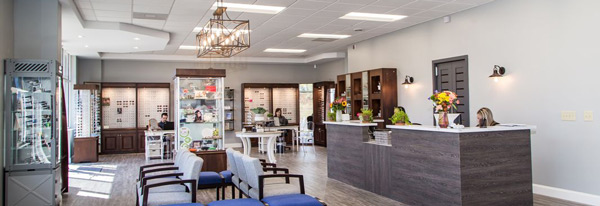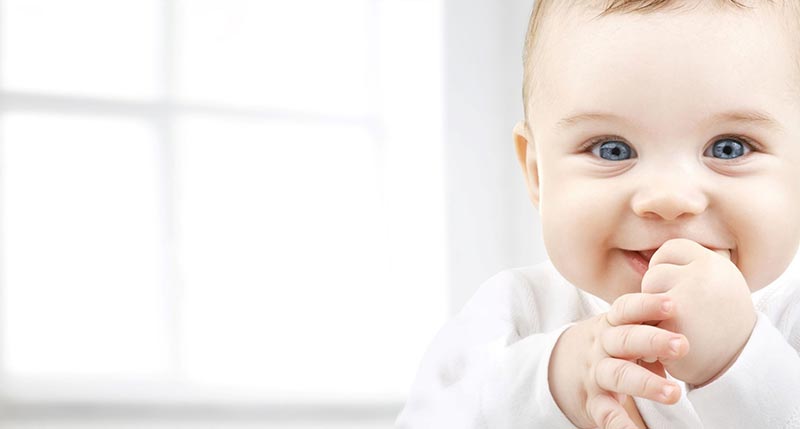A New Parent’s Guide to Your Baby’s Vision Development
We get it: Having a baby can feel overwhelming. Caring for an adorable new life is a big job, and there’s a lot to learn. One important area of focus new parents sometimes overlook is your baby’s vision development.
Many new parents are unaware that an optometric vision exam for their new baby is as important as those pre-scheduled pediatric exams. Ideally, at about 6 months of age, a baby should have their vision evaluated by an optometrist to ensure their eyes and vision are developing properly. An infant’s eye and vision health are directly connected to their motor, speech, and social development. The sense of sight is a critical aspect in your baby’s development.
Babies aren’t born with the ability to “see” as we adults perceive our sense of sight. Instead, they “learn to see” over a period of time. Just as they learn to roll over, sit up, crawl, and walk, their eyes must learn to focus, track, and pinpoint objects to help them explore, interact, and understand their world. A baby’s eyes are the tool that leads them forward in their development – sight is their window to the world!
As a new parent, it’s crucial for you to be aware of the vision developmental milestones below. Remember, however, that every child is unique, and these are general guidelines.
Birth to 4 Months
Newborns can focus on objects approximately 8 to 10 inches from their faces. However, they can’t yet move their eyes to track an image or object. For her first two months of life, your baby may appear to have crossed eyes or eyes that wander, which is usually normal. However, if this happens constantly, an eye evaluation is warranted. At approximately three months, a baby should begin to visually track objects and reach for them as eye-hand coordination develops.
Things parents can do to assist with visual development:
- Alternate left and right sides when feeding to give the baby a different reference point
- Talk to your baby as you walk around the room to help him with tracking
- Change the crib position and the baby’s position in that crib
- Keep toys within 8 – 12 inches from the baby’s reach to help with focus
- Use low-wattage lamps or dimmers in the baby’s room
Age 5 to 8 Months
Around 5 months of age, eye-hand and eye-body movements improve as the baby’s eyes begin working together. At this point in development, your baby can form three-dimensional images, and it is generally believed a baby’s color vision is developing.
At 8 months, most babies are crawling and developing a greater ability to utilize eye-hand and body coordination. Parents should encourage their baby to crawl more (rather than walk early) as it may help their eyes “learn” to work together.
Things parents can do to assist with visual development:
- Give the baby plenty of “floor time”
- Give the baby hand-size blocks to hold
- Hang mobiles or other objects across the crib for the baby to reach for, kick, or grab
- Play games holding the baby’s hands and go through the motions with them – like “Patty Cake” and sing or say the words to them
Age 9 to 12 Months
At 9 months, a baby should be using the thumb and forefinger to grasp objects— indicating good depth perception and eye tracking. As the baby approaches 12 months of life, they begin to walk and judge distance fairly well. They also begin throwing objects at a desired location.
Things parents can do to assist with visual development:
- Hold objects within the baby’s line of sight and name the object to encourage word association and vocabulary
- Help visual memory by playing Peek-a-Boo or Hide-N-Seek with toys
- Encourage scooting, crawling, and walking by holding out a desired toy
Age 1 – 2 Years
A child’s depth perception and eye-hand coordination should be well developed. They recognize and respond to pictures, books, and toys.
Activities to assist with visual development:
- To help with fine motor skills and small muscle development, give the child small blocks and toys to play with
- Read books and tell stories to help the child visualize and build vocabulary
- Roll or pitch a soft ball to the child to help them with tracking ability
Early Signs of Eye and Vision Problems
Though rare, vision or eye problems in a baby can develop, or sometimes babies are born with vision issues. Vision problems can lead to delayed development due to the lack of visual information being sent to the brain. An early eye exam can identify vision concerns and enable correction or treatment so that your child can develop appropriately.
As a parent, be alert to these signs that could indicate vision or eye problems:
- Encrusted or red eyelids, discharge or pus coming from the eye (indicating infection)
- Extreme sensitivity to light (may be related to elevated eye pressure)
- Constant eye turning (indicating a muscle control issue)
- Excessive tearing (which may be a clogged or blocked tear duct)
- Appearance of a white pupil (which can be an indication of a malignancy)
Babies born with a medical condition such as prematurity, Down syndrome, or neurofibromatosis, among others, are especially susceptible to vision problems and should be screened early. Additionally, parents should inform their optometrist if there is a family history of lazy eye, misaligned or crossed eyes, refractive errors, retinoblastoma, congenital glaucoma, or congenital cataracts.
A baby whose siblings have vision problems will have a significantly higher risk of developing eye issues and should be monitored by your optometrist.
Baby’s First Eye Exam
Parents play an integral role in their infant’s visual development. One smart way to ensure your baby’s vision is developing well is to schedule your baby’s first eye exam.
Your optometrist will check for farsightedness, astigmatism, and nearsightedness as well as eye alignment and tracking ability. Early detection and treatment offer the best options for normal development and to give your child the best possible quality of life.


